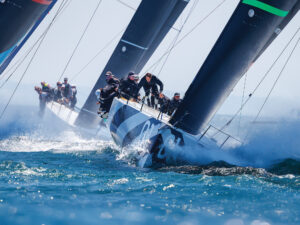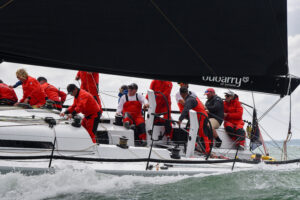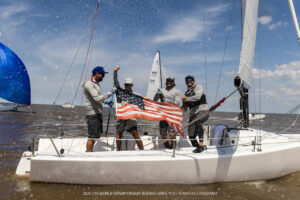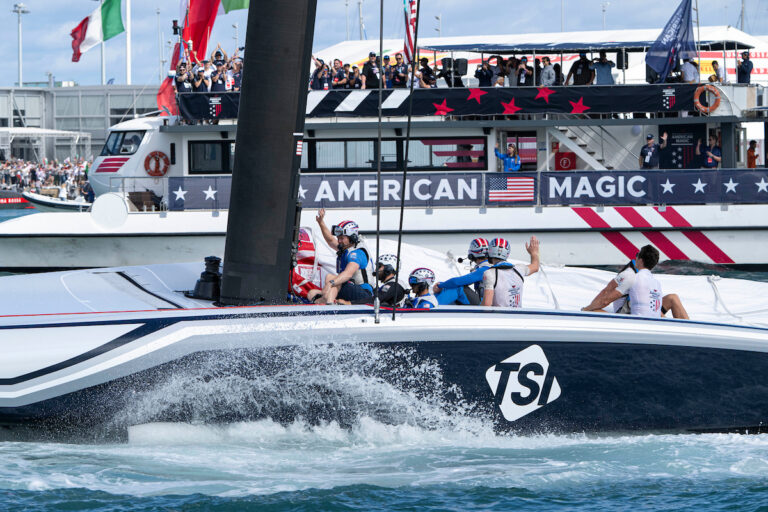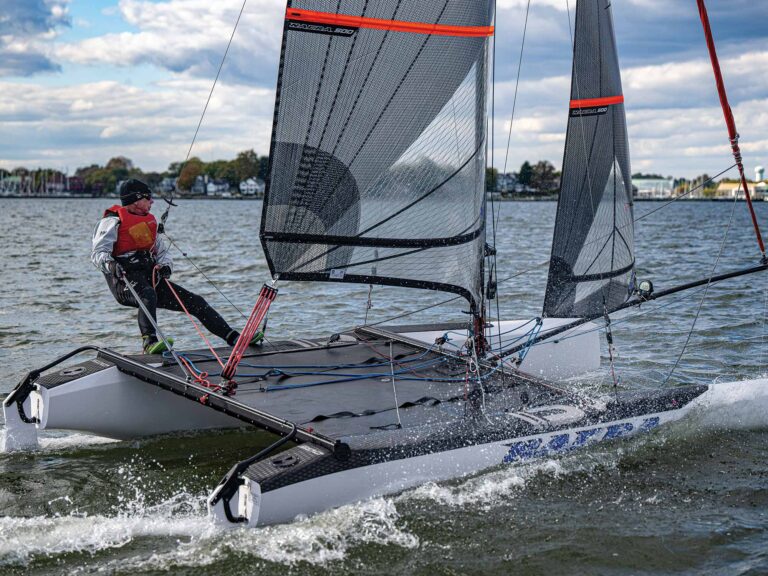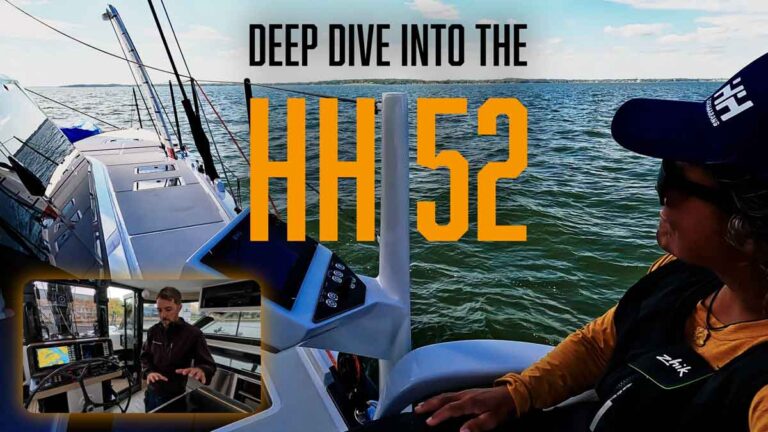
What makes a legend? Start with one sheet of plywood.
At the launch in 1963, there was, of course, no legend. The humble plywood that formed the hard-chine hull of Infidel, later to be known as Ragtime, was sheathed in fiberglass and never again fully revealed until a complete overhaul for the boat’s latest shepherd, Tina Roberts.
There’s a lot to unpack. The 26,000-pound displacement, half that of 62-footers of the day, was a shocker. Legends are like that. And this legend wouldn’t shine half as brightly if the boat hadn’t been refused entry to the 1967 Sydney Hobart as unfit for ocean racing. Or if it hadn’t returned to sail the Hobart race 31 years later and win its division. That achievement was sandwiched between a 3,571-mile course record, Los Angeles to Tahiti, and a triumphant return to its native New Zealand waters.
Roberts knew what she had when the boat came to her, along with an important order of business: to be the first entry for the 2025 Transpacific Yacht Race, Los Angeles to Honolulu, this July. To pay that off, Roberts went the extra mile to ensure a future for a classic. That is why this is a story.
Infidel had earned a stellar track record by 1969, when it was brought from New Zealand to Southern California, renamed Ragtime, and raced with tweaks through a series of owners. In its first Transpac, in 1973, Ragtime went up against the longer waterline of Windward Passage, course record holder and well on the way to its own place in the pantheon. Passage was favored for another first finish, or perhaps the new IOR maxis Blackfin or Ondine. Ragtime lay in the background as a long shot in a slow race where the weather briefing included a number for calling Dial-a-Prayer.
Fast-forward a couple thousand miles, and prayers indeed may have been uttered as Ragtime and Passage came within sight of each other late in the race and contested the lead for the final 36 hours, exchanging leads, eking out every knot. The second night of their drag race arrived with a sparkling full moon, and Honolulu sailors—alerted to the drama by commercial radio—headed for Diamond Head in droves. As the rivals closed in on the finish, eyeing each other’s running lights, spinnakers flush with trade wind at last and not quite neck and neck, it was a race, all right.
The ride would have been one thing on Passage, 10 feet longer with a beam of 20 feet and, by comparison, a sense of space and solidity. The crew of Ragtime, low-slung and hitting speeds in the 20s on 12 feet of beam, would have had, shall we say, a more intimate experience of the sea. As in, driving through waves and soaking the helmsman, who couldn’t have cared less. He was working hard and staring into a mass of confusing red and green lights from the spectator fleet.
Yet, the finish was out there, and 40 seconds after midnight, Ragtime took the squeakiest barn-door win in the annals of Transpac: 4 minutes and 31 seconds after 254 hours on the course, a 0.018 percent differential over Windward Passage.
Transpac historian Jack Smock identified 1973 as “Act 1, Scene 1 of the great ULDB controversy.” That controversy was cultural as well as practical. Considering the entries, a late-formed ratings committee had been charged with hurriedly developing a way to handicap Ragtime and two other quick Spencer designs, plus three ultralight displacement boats from Bill Lee. The question was how to rate these new thingamajigs so that we could all live together. Bill Lapworth, naval architect for the revolutionary-in-its-day Cal 40, was on that committee, which made bets for the ’73 fleet that didn’t necessarily pan out.

A light boat was the horse for the course. Ragtime was witchy fast downwind. Downwind sailing was the critical feature—and the attraction—of a race from California to Hawaii. So, OK, boats were changing, but when Ragtime also won second place on time allowance, that bothered some people. At the smaller end of the fleet was a standout 35-footer that Lee designed and built in his other world of Santa Cruz as an uncompromised ultralight. Chutzpah caused a stir when it arrived with no through-hull fittings, a portable toilet, and a plan to cross on freeze-dried rations, weight minimized to the max. Transpac raised its rating, and Chutzpah won overall.
For the record, there were people who argued that boats like Chutzpah simply shouldn’t be allowed to race in a contest whose traditions dated to 1906. It would be 38 years before Bill Lee became commodore of the Transpac Yacht Club.
Coming to the ‘75 race, Transpac further stiffened the time assessments on lightweights. ULDB skippers called them penalties. But Ragtime and Chutzpah were back. Could they repeat?
Yes and no. Ragtime was first to finish, again, this time by eight hours. Under the new time corrections, it fell to seventh in Class A and 52nd in fleet, but who cares when you finish first? Then Chutzpah corrected to first overall, again, and people cared. Despite an added-added time penalty, and with or without a universal welcome, change had arrived. Soon a generation of “sleds” would come along—inspired by Ragtime, gunning for Ragtime. What makes a legend?
Good years followed, with race wins here and there. Even with no more special finishes in repeated Transpacs, Ragtime was special. Nevertheless, it was a dog-eared Ragtime that went up for auction in 2003, acquired by California yachtsman Chris Welsh and others, and eventually owned entirely by Welsh. He soon had the boat and showed it the love it deserved, racing and traveling ambitiously.
Ragtime had 15 Transpacs behind it in 2021 when Welsh passed away suddenly, leaving longtime business partner and life partner Roberts to take the helm. From there, a personal story intensifies, so let’s take a break for housekeeping.
Cherry-picking from a long list, Ragtime for the 2025 Transpac was taken down to the wood and resheathed in two layers of carbon. Its bulb keel dates to 2008, but the carbon mast is newly installed off a European TP52 and supported with EC3 carbon rigging. A square-top mainsail adds 309 square feet to the original 720. Think beefed-up mast step, bigger spinnakers, lighter engine, carbon winches, obsessive (critical) detailing, and an overall displacement reduced by 2,000 pounds from the original. A stern scoop stretches the hull to 65 feet LOA.
Roberts took over Welsh’s mission of reinvention, but now we need to reach back in time for her story, where nothing except, perhaps, a spirit of adventure hinted that this younger Tina would one day be here. At 24, she loaded up a Dodge pickup truck in Idaho and towed a Catalina 25 to Anacortes, Washington, and launched. “I had a fantasy of sailing around the islands, and it would be romantic and the weather would be fabulous, but what I got were gray skies and wind and rain and rain and more rain. I fell in love with it.”
OK, she passed that test.
Advance to 2009. Riding her motorcycle to a blind date with Chris Welsh at a Rolex Big Boat Series didn’t put him off, as she thought it might, and the plot thickened. The way Roberts tells it, Welsh was at the top of his game, and neither of them needed a relationship. Besides Ragtime, Welsh was preoccupied with a stable of personal submersibles, plus the 124-foot catamaran Cheyenne (which has a history unto itself) used as a tender. That was a lot to absorb, but life happened and so did a relationship. Roberts said: “At that point, Chris was returned from his Pacific tour—Tahiti, Australia, New Zealand—and he put Ragtime on the hard. She sat for years at Sugar Dock,” a facility that Welsh owned on the eastern shore of San Francisco Bay. “When COVID hit, he declared it the perfect time to start pulling the boat apart and begin putting it back together better. He was doing that alongside other things, like taking submarines all over the world during a pandemic. Our heads were spinning.”
The proceedings did not all make sense to Roberts. Certainly not finding herself in a cabin in a cornfield in Germany talking to a man about a lightweight engine from a miniature Mercedes. Nor buying a mast in Spain for $5,000 and paying $2,000 to ship it.

“But all that crap that piled up at Sugar Dock was part of Chris’ vision for Ragtime,” Roberts says. “He thought so far in advance. Now I know that a carbon mast costs hundreds of thousands of dollars, and every item in that pile at Sugar Dock was a piece of the puzzle that I needed.”
But needed for what? Executing Welsh’s vision was no small matter, and it was black-box stuff to Roberts. The learning curve was well-nigh vertical. Knowing that naval architect and Transpac YC Vice Commodore Alan Andrews had history with the boat, “I called Alan and said, ‘I just don’t know what to do. Will you help me?’ He said no.
“I said, ‘What? I’m offering to pay you.’”
“He said: ‘No, because any owner of Ragtime is involved in everything that goes into the boat. You want to pay me to just get it done, and I’m not interested in that.’”
“I thought, Who the hell is he?”
Roberts had friends who advised her to sell and move on. She thought so too, “but a couple of months into 2022, it didn’t feel right. I called Alan again and said, ‘I want to do this.’ He said: ‘Great, I’m in, and you’re going to be in on every detail. You’ll figure it out.’”
The path forward led to Dennis Choate’s yard in Long Beach, and Choate said, “We don’t have room.” But room was found. The path led to Jimmy Slaughter, who had recently led a million-dollar refit of Merlin. He said, “No, I’m out of that business.” But he came. He came for Ragtime, the way Ernie Richau, known as a navigator rather than a project boss, came aboard, to take over for the previous captain, who lost his house in the Altadena fire.
Along the way, Roberts learned to make decisions. Looking back, she says, “the key was to not ask how much will this new thing cost but what will be the impact on the sailing.”
Personality differences among Andrews, Choate, Slaughter and Roberts made for some lively discussions, apparently, but all were of one mind that they were working on something bigger than themselves and, for that matter, bigger than a boat. Along the way, that “something” sank in.
“Alan told me to feel the boat in my soul,” Roberts says. “It’s a part of my skin, right? For every owner I’ve talked to, their time with Ragtime was like that—a defining moment. This will sound crazy, but I believe that Ragtime, in a way, chooses her owners. I feel chosen. I don’t take it lightly.”

